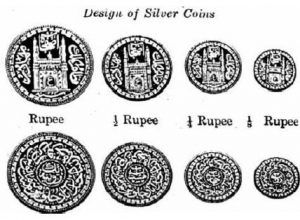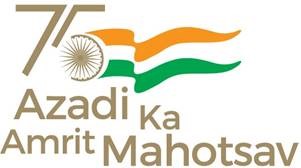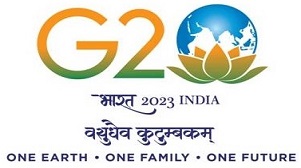ABOUT US
- Profile
- Organization Structure
- History
Profile
India Government Mint, Hyderabad (‘IGM Hyderabad), a unit of Security Printing And Minting Corporation of India Limited (‘SPMCIL’) is one of the four Mints that is engaged in the manufacture and supply of coins to Reserve Bank of India for the purpose of circulation. It is an ISO 9001:2015 and ISO 14001:2004 certified unit.
The present mint, started in 1997 at Cherlapally, is equipped with modern machinery supplied by world’s leading OEMs. IGM Hyderabad manufactures coins of Rs.10, Rs.5, Rs. 2 and Rs.1 denominations. It produced 1,513 million pieces of circulating coins during FY 2016-17.
IGM Hyderabad is engaged in end-to-end processes for coin production – melting, rolling, blanking, annealing, pickling & polishing and stamping.
The total turnover of the unit in FY 2016-17 was Rs. 566.88 crores.
Organization Structure
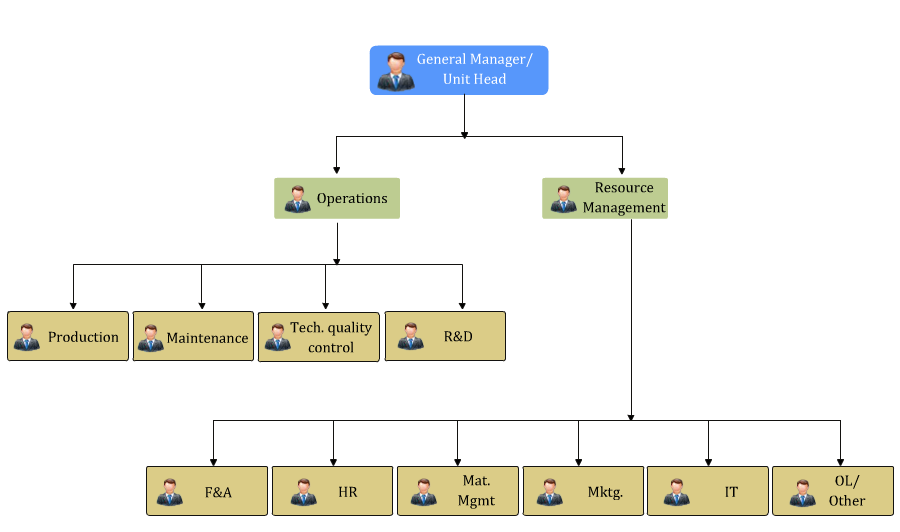
History
India Government Mint Hyderabad is a Unit of Security Printing & Minting Corporation of India a Central Public Sector Enterprise (SPMCIL), Schedule “A” Mini-Ratna Category-I wholly owned by Government of India. The mint was originally established in 1803 as the Royal Mint to serve as the mint for the Nizam of Hyderabad. In 1950, the mint was taken over by the Government of India, and Mint was inaugurated on 28th August 1997 at Cherlapally where the Mint at Saifabad was completely shifted on 1st November 2001, and it started operation fully.
The Mint is one of the prestigious organizations in twin cities of Hyderabad and Secunderabad. This gigantic task was successfully completed under the supervision of the Central Public Works Department and the consultancy from MECON. Central Industrial Security Force is providing the security to the plant with security surveillance system.
This is the most modern minting unit in the country with modern machinery to produce 700 Million pieces of coins and 950 Million pieces of blanks to meet the growing demand equipped with State of Art facilities on the lines of International standards and is one of the Asia’s biggest Mint having refining facility as well as facility to mint coins, medals and medallion. The Company has well defined procedures and guidelines for smooth operations and its officers discharge their respective functions within the norms set through. Also The Company has procedural manuals covering all important activities viz. Personnel Manual, Accounts Manual and Internal Audit Manual, etc.
The unit has a battery of experienced, skilled and trained manpower totalling around 500 in production, control and maintenance areas to effectively and efficiently discharge the responsibilities assigned by the Government. A large number of the personnel had received requisite training at the time of starting of the mint and constantly the skills of the employees are updated by providing suitable training whenever the new machinery is added to the unit. This unit can boast of having a dedicated team of officers, staff and workmen who brought laurels to the organization by standing ahead of all the Mints in fulfilling the targets set for the Mint.
The campus is spread over an area of 80 acres of land. Apart from the high security-minting complex, it has residential complex for essential staff (nearly 100 quarters) with well-supported infrastructure. The factory and colony is nearly self-dependent for all its basic needs.
During its past over 100 eventful years (centenary) of its existence, Mint has crossed many milestones and has earned the reputation as a reliable and potential Mint in meeting the requirement and demand of Reserve Bank of India all the time. Until beginning of last century Minting operations were carried out in various DARUZ-ZARAB in the country. These private Mints were operated by Omara’s (wealthy men) , Sahukars (Businessmen) and Jagirdars (Counts). They had to pay a huge fee to Royal Exchequer in order to obtain license for minting coins. They used to strike coins with the name of Emperor in Delhi, then added FIDVI with inscription of their own QITAAB (Title) followed by the word YAR-E-WAFADAR Trusted follower). A typical example was that Peston , Miherji, a Bombay Sahukar who was licensed by Diwan Chandulal to strike coins in Aurangabad. These coins were famous as Peston Sahi coins.


First Royal Mint was established under Nawab Sikandar Jah, the third Nizam of Asaf Jahi dynasty in 1803 A D (1212 Fasli, 1218 Hizri) at a place called Sultan Sahi near Mogalpura, Charminar in Hyderabad. Royal Mint operated along side other private Mints which produced coins in the name of Emperor similar to mentioned earlier.
Halli Sicca Coins : In 1858, after Mutiny and dissolution of Moghul Empire by British, all Mints through out India were abolished except those of a few privileged states like Nizams and two Government of India Mints in Bombay and Calcutta. Coins then produced ceased to carry the name of Emperor in Delhi no longer. Instead coins of Hyderabad Royal Mint were inscribed with the initial letter of Nizam as well as name of Dynasty and the numeral 92. The number has a religious significance and represents the sum of the symbolic numbers of the letters in the prophets’ name. These coins were known as Halli Sicca meaning current coins. These coins were produced in Darush-Shifa Mint and the quality was more or less similar to earlier coins.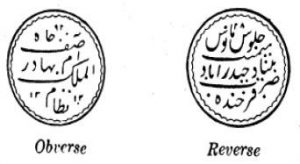
Charkhi Coins : (Means machine made Coins) In 1895, machinery was first introduced and a new class of coins known as Charkhi (Wheel) made its appearance. A fascimile of charkhi’s rupee coin is produced below from which it will be seen that 1 Rupee, 8 Annas, 4 Annas, 2 Annas in Silver and 6 Pie and 2 Pie in Bronze are produced Apart from that, Gold Ashrafi, 1/2 Ashrafi, 1/4 Ashrafi and 1/8 Asharafi were also produced They were, however, not used in general circulation. Later these coins came to be known as Osmania Sicca, when new Nizam Osman Ali Khan acceded the throne in 1911. These coins are 1st Modern Series coins. Their specification such as size, alloys, weights were very pucca (Specific). A Currency Act was also notified in 1911, bearing exact specifications of coins for use as a legal tender. During 1st World War (1914-1918) silver cost went up considerably and all lower denomination silver coin below Rupee were replaced by Nickel & Copper coins simultaneously. Paper Currency Act was introduced in 1918 by which Rs. 10, Rs. 100 notes were introduced. Initially these notes were printed and imported from a place called waterloo in U.K. Later these notes were obtained from Government of India Currency Note Press, Nasik
In 1948, the State of Hyderabad came under the control of Government of India. The Nina of Hyderabad was made Raja Primacy. Minting of Omani Sickka was continued in Saifabad Mint until middle of fifties. Thereafter Government of India introduced decimal coin in 1957 soon manufacturing of 1 Paisa , 2 Paisa, 3 Paisa, 5 Paisa, 10 Paisa,, 25 Paisa and 50 Paisa were taken up. Administratively, Hyderabad Mint was under control of Bombay Mint from 1948 to 1962 until Shri B.S. Ayer took charge of Hyderabad Mint as Master of Mint. Thereafter Hyderabad mint functioned independently and reported directly to Ministry of Finance, Department of Economic Affairs, under Government of India, New Delhi. Over the years there were many changes on machinery as well as coinage alloys. A second shift in night was introduced into enhanced production. The strength of staff and workmen rose to nearly 1200. The production touched 2.0 million pieces per day. Initially lower denomination unto 50 paisa was struck in